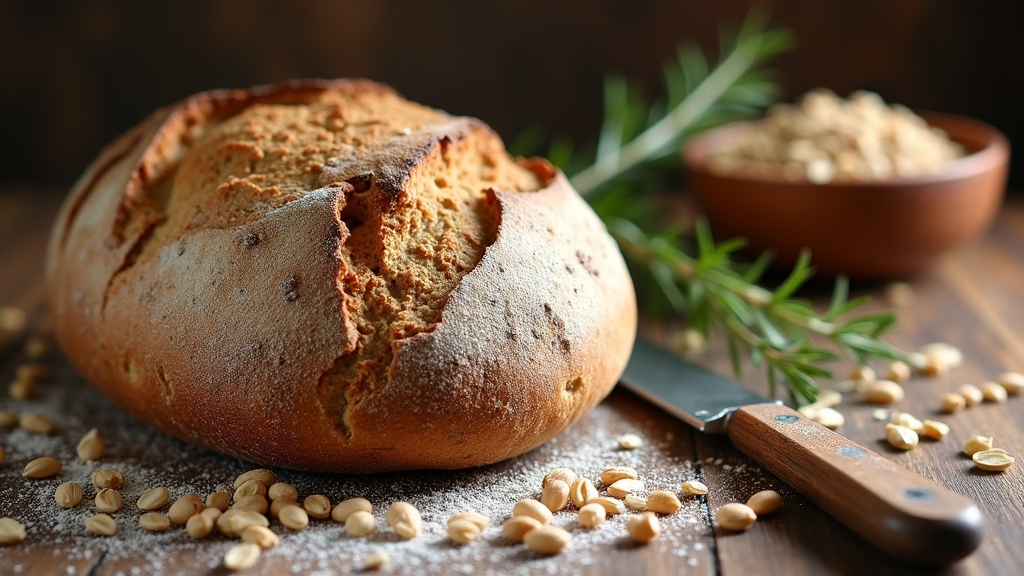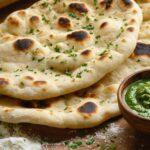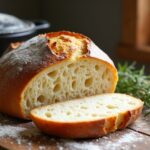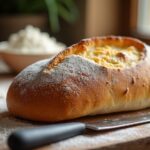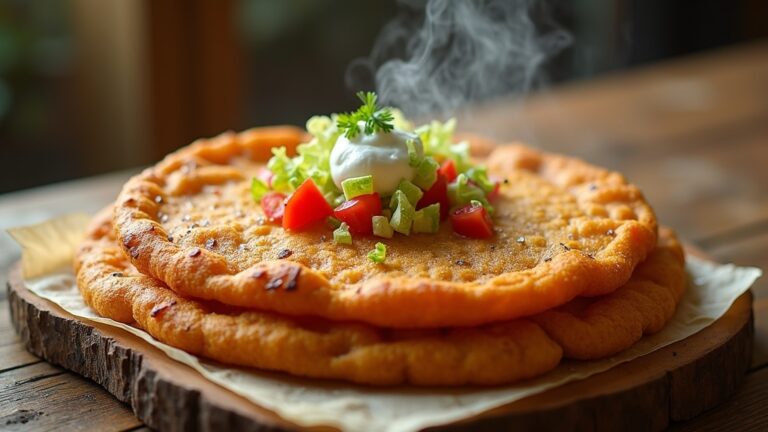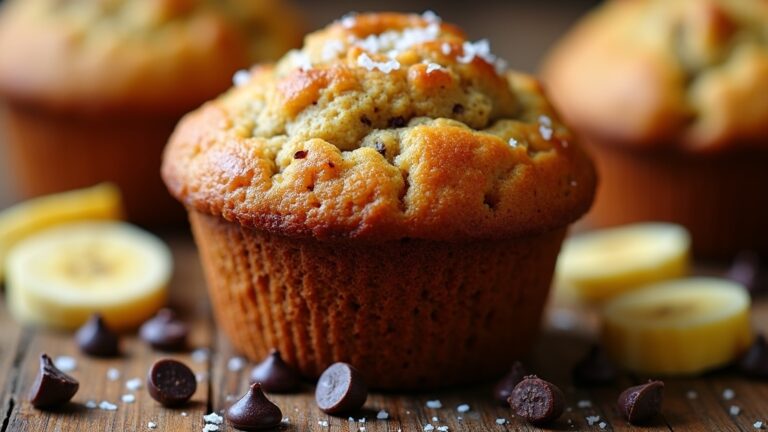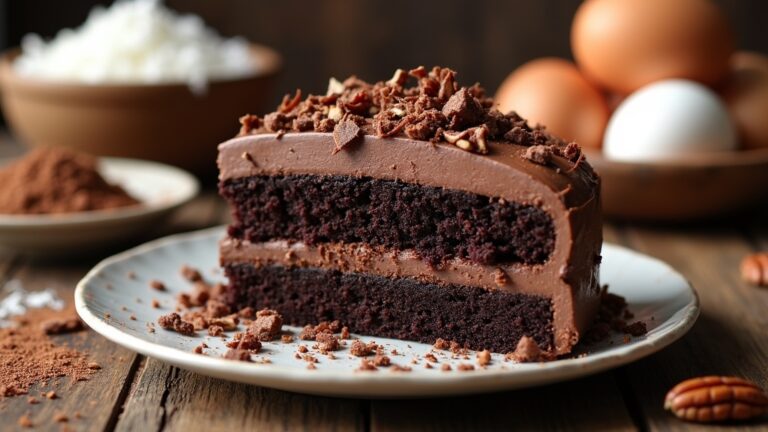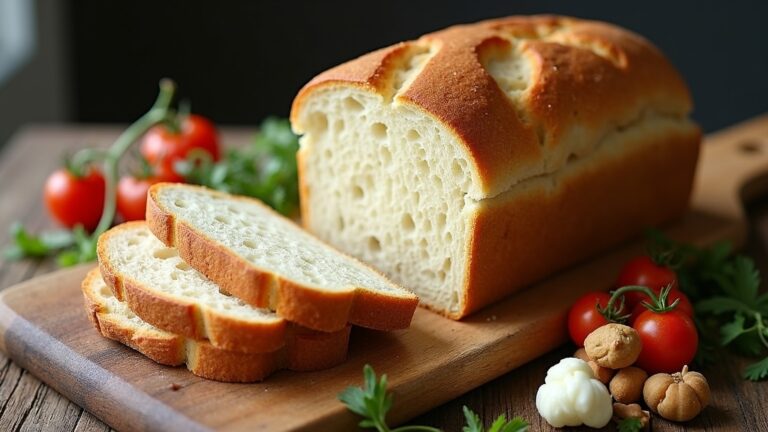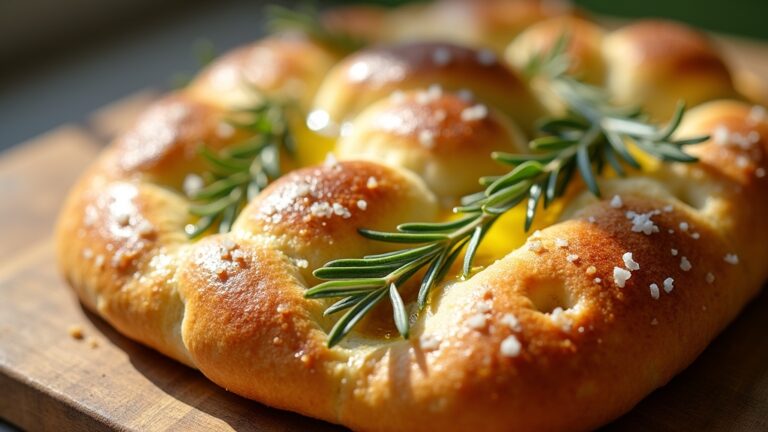Whole Grain Bread Recipe
If you’re looking for a whole grain bread recipe, you’ll love how simple and rewarding it is! I combine whole wheat flour with warm water, yeast, and a dash of salt, then knead it to perfection for that crusty exterior and soft interior. After letting the dough rise, I shape it into a loaf and bake it until golden brown. This bread is not just nourishing, but it’s also versatile for various meals and snacks. Stick around to discover more tips and benefits!
Contents
History
When I plunge into the history of whole grain bread, I can’t help but marvel at its origins that stretch back thousands of years. It’s fascinating to think about how ancient grains like spelt, einkorn, and barley laid the foundation for our modern diets. These grains weren’t just a source of sustenance; they held immense cultural significance. In ancient civilizations, bread was often seen as a symbol of life and community, bringing people together in celebration and shared meals. As I explore these rich narratives, I see how innovations in bread-making have evolved, yet the essence of whole grain bread remains rooted in tradition. Each bite connects us to our ancestors, reminding us of the timeless importance of nourishing our bodies and spirits.
Recipe
Whole grain bread is a wholesome and nutritious choice for anyone looking to enjoy a slice of something hearty and healthy. Packed with fiber and essential nutrients, this bread can be a delightful addition to your meals or a perfect standalone snack. While it might seem intimidating to bake bread from scratch, the process is quite simple and rewarding. Plus, the aroma of freshly baked bread filling your home is simply unbeatable.
Whole grain bread offers a nutritious and satisfying option that enhances meals and fills your home with a delightful aroma.
This recipe yields a delicious loaf of whole grain bread that is crusty on the outside and soft on the inside. The combination of whole wheat flour and other grains not only enhances the flavor but also provides a range of health benefits. Whether you prefer it toasted with a bit of butter or as the base for a sandwich, this bread is sure to satisfy your cravings and keep you feeling full for longer.
Ingredients:
- 2 cups whole wheat flour
- 1 cup bread flour
- 1 cup warm water
- 2 tablespoons honey or maple syrup
- 2 tablespoons olive oil or melted butter
- 1 packet (2 1/4 teaspoons) active dry yeast
- 1 teaspoon salt
- 1/4 cup rolled oats or seeds (optional)
To make the bread, begin by mixing the warm water, honey, and yeast in a bowl. Allow it to sit for about 5-10 minutes until it becomes frothy. In a separate large bowl, combine the whole wheat flour, bread flour, and salt. Once the yeast mixture is ready, stir in the olive oil and then pour it into the dry ingredients. Mix until a dough forms, and then knead the dough on a floured surface for about 10 minutes until it becomes smooth and elastic. Place the dough in a greased bowl, cover it with a cloth, and let it rise in a warm place for about an hour or until it doubles in size. After rising, punch down the dough, shape it into a loaf, and place it in a greased loaf pan. Let it rise again for about 30 minutes, then preheat your oven to 375°F (190°C) and bake for 30-35 minutes until golden brown. Let cool before slicing.
When baking whole grain bread, it’s vital to ascertain that your ingredients are at the right temperature, especially the water, which should be warm but not hot. Additionally, feel free to experiment by adding seeds, nuts, or even dried fruit to enhance the flavor and texture. If you prefer a softer crust, you can cover the loaf with a kitchen towel just after baking. Finally, store any leftover bread in an airtight container to keep it fresh for longer. Enjoy your homemade whole grain bread!
Cooking Steps
Now that we have our ingredients ready, let’s jump into the cooking steps that will bring our whole grain bread to life. I’ll guide you through measuring the flour, mixing in the yeast and water, and kneading the dough until it’s just right. Trust me, watching the dough rise and then shaping it into a loaf is one of the most satisfying parts of the process!
Step 1. Measure Whole Grain Flour
To achieve the perfect texture and flavor in your whole grain bread, it’s essential to measure the flour accurately. I prefer using the spoon-and-level method, where I gently spoon the whole grain flour into a measuring cup and level it off with a knife. This technique prevents packing, which can lead to dense bread. Different flour types, like whole wheat or spelt, may absorb moisture differently, so adjusting your measurements might be necessary. If you’re feeling adventurous, try weighing your flour with a kitchen scale for even more precision. This way, you can guarantee you’re getting the right amount every time. Trust me, these measuring techniques make all the difference in creating that perfect loaf!
Step 2. Add Yeast and Water
After measuring your flour, it’s time to bring your bread to life with yeast and water. I love experimenting with various yeast types, such as active dry yeast or instant yeast, each offering unique flavors and textures. I gently warm my water to about 110°F, ensuring it’s neither too hot nor too cold, as this temperature activates the yeast perfectly. If it’s too hot, you risk killing those tiny organisms, while cold water can delay the rising process. Once the water’s ready, I sprinkle the yeast over it, letting it dissolve for a few minutes. The bubbles forming are a sign that your yeast is alive and kicking, ready to create a delightful loaf that’s bursting with wholesome goodness.
Step 3. Knead the Dough Thoroughly
As I plunge into kneading the dough, I can already feel the magic of the yeast working its wonders. I use a combination of pushing, folding, and turning—a blend of kneading techniques that transforms the mixture into a smooth, elastic ball. It’s important to observe the dough consistency; it should be soft but not sticky. If it clings to my hands too much, I sprinkle a bit of flour to adjust. With each rhythmic motion, I can sense the gluten developing, creating that perfect structure we crave in whole grain bread. This process usually takes about 8-10 minutes. Kneading isn’t just exercise; it’s an essential step that’s key for a delightful, airy loaf.
Step 4. Let Dough Rise Double
With the dough kneaded to perfection, it’s time to let it rise and work its magic. I place the dough in a lightly greased bowl, covering it with a damp cloth to lock in moisture. This step is essential for effective dough fermentation, allowing the yeast to awaken and work its wonders. I choose a warm spot in my kitchen, as the right temperature enhances the rise techniques, creating a cozy environment for the dough. As it rises, I watch in awe, knowing it should double in size. Patience is key here—every minute adds flavor and texture. After about an hour, I’m ready to reveal a beautifully puffed dough, brimming with potential for my whole grain bread.
Step 5. Shape the Dough Loaf
Once the dough has risen to double its size, it’s time to transform it into a loaf. I start by gently deflating the dough on a lightly floured surface, embracing the tactile joy of dough shaping. Using my hands, I fold the dough over itself, creating tension, which is essential for a well-structured loaf. I then roll it into a tight cylinder, ensuring the seams are pinched together securely.
For innovative loaf techniques, I consider shaping it into a batard for a rustic touch or a classic sandwich loaf for versatility. Placing it in a greased pan, I let it rise again briefly, allowing the flavors to meld before baking. This shaping process sets the stage for a beautiful, flavorful bread.
Nutritional Guide
Understanding the nutritional value of whole grain bread can transform your meal planning and enhance your overall health. Whole grain bread is packed with health benefits, primarily due to its high fiber content. Fiber aids digestion, promotes satiety, and helps regulate blood sugar levels.
Here’s a quick overview of its nutritional profile:
| Nutrient | Per Slice (approx.) | % Daily Value* |
|---|---|---|
| Calories | 80 | 4% |
| Fiber | 3 g | 12% |
| Protein | 4 g | 8% |
| Whole Grains | 16 g | – |
Incorporating whole grain bread into your diet not only elevates your meals but also supports your health journey.
Final Thoughts
Whole grain bread isn’t just a nutritious choice; it’s a versatile staple that can enhance various meals. I’ve found that embracing this wholesome ingredient opens up a world of culinary possibilities. Whether you’re slathering it with avocado for breakfast or crafting a gourmet sandwich for lunch, the rich flavor and texture are unbeatable. If you’re looking to elevate your baking game, remember these baking tips: always measure your ingredients accurately, and don’t rush the kneading process. The health benefits are remarkable too—whole grains can boost heart health and aid digestion. Experiment with different grains and add-ins to create a personalized loaf. I encourage you to make this bread a regular part of your kitchen repertoire; your body and taste buds will thank you!
Frequently Asked Questions
Can I Substitute Whole Wheat Flour With Other Flours?
I’ve experimented with various flour types like spelt and oat. Each brings unique texture variations, transforming my baking experience. Don’t hesitate to try new combinations; innovation in the kitchen leads to delightful surprises!
How Can I Store Whole Grain Bread for Freshness?
Did you know bread stored properly can last up to three months? I love using freezing methods for long-term freshness, but if you prefer refrigerator storage, wrap it tightly to prevent staleness and moisture loss!
Is Whole Grain Bread Suitable for Gluten-Free Diets?
I’ve found that whole grain bread isn’t typically gluten-free, as it usually contains wheat. However, using gluten-free ingredients and innovative alternative grains opens up delicious possibilities for those on gluten-free diets.
How Long Does It Take to Bake Whole Grain Bread?
When I bake whole grain bread, it typically takes about 30-40 minutes at a baking temperature of 375°F. After letting the dough rise, I love watching it transform into a delicious, golden masterpiece!
Can I Add Seeds or Nuts to the Whole Grain Bread Recipe?
I love adding various seed varieties like sunflower or chia, and nut types such as walnuts or almonds, to enhance flavor and texture. It really elevates the bread and makes it uniquely delicious!
Conclusion
As I savor the warm, nutty aroma of freshly baked whole grain bread, I can’t help but feel a sense of accomplishment that’s as comforting as a warm hug. This recipe not only nourishes the body but also connects us to a rich history of baking. I encourage you to give it a try; each slice is a reflection of the joy of creating something wholesome and delicious in your own kitchen. Happy baking!
